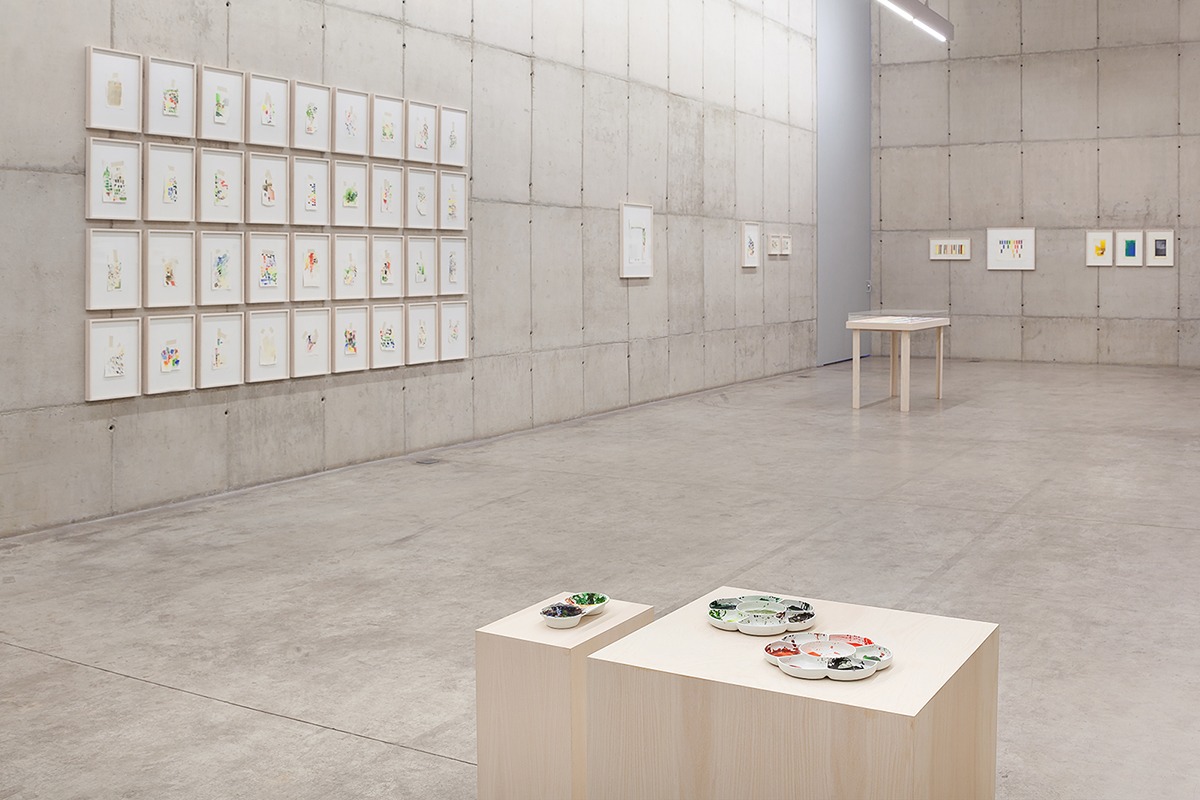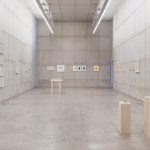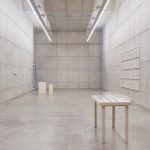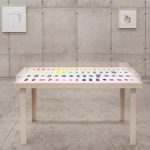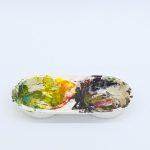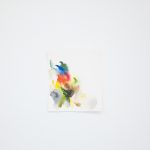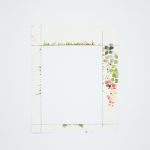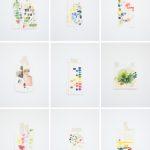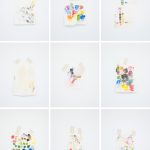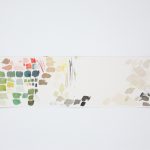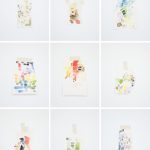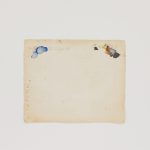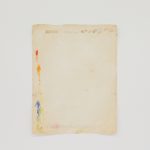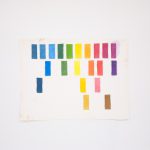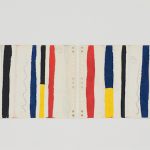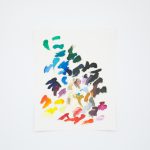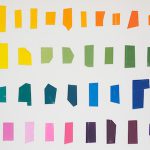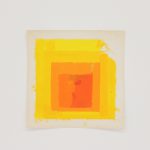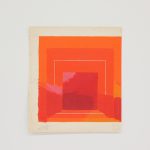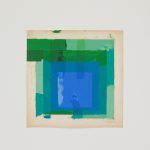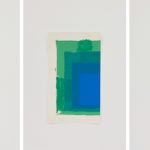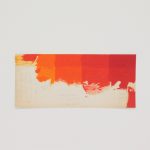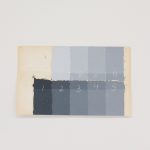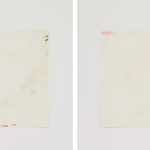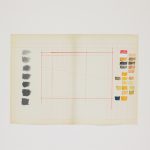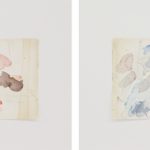After
In a legend told by the Romans, two virtuoso painters entered into a dispute in order to define who among them was the superior artist. Zeuxis revealed such a realistic painting that the birds tried to eat the grapes, and bragged about deceiving the animals. Parrhasius, in turn, asked his rival to unveil his piece by pulling the curtain that covered it. Zeuxis realized, when he tried to pull the fabric, that the curtain was painted, being himself deceived.
When entering Mauro Piva’s studio for the first time, one could see a series of paper scraps taped on large white cardboard sheets. On the torn pieces, messy coloured stains of different shades and sizes – small solid tinted rectangles, large watery blotches, and lines varying in thickness and texture. There were more than thirty pieces on the wall. At first sight, there was only one conclusion: the artist had saved, and now organized, several colour tests of distinct proportions and densities, appropriating the scraps his own work; he then attached the painted slips with crepe tape onto neutral backgrounds as a way of displaying them.
After gazing at the details, however, the eye began to see small distracting distortions. The different materials of what was presumably a series of collages seemed to merge together and, at times, the sticky tape appeared to be an illusion, or the juxtaposition of the papers revealed itself as a single sheet that had been cut and ripped to pull the layers, even revealing the wall behind it.
This new series is, on one hand, an extension of a long research carried out by the artist. In 2013, for example, he developed works that simulated the presence of several pieces of adhesive tape glued on the surface of the paper sheet, while actually using only paint and a stylus to enact, on a single medium, the overlapping of two distinct materials. In this same body of works, he commissioned aluminium objects shaped as rolls of tape and then painted them to emulate the real product. His Post-itesquemas and Bilhetes followed the same logic: using a singular sheet of thick paper, he would mimic small pieces of notebook pages or post-its glued to a neutral base, misleading the spectator.
The process of creating simulacra is strenuous and demands time, from outlining the mask that distinguishes object and background, to the skill of handling the blade to peel the paper fibres, passing through the virtuosity of reproducing in the most perfect way possible to the human hand the lines, traces and textures of the copied materials. For this exhibition, Piva goes further and appropriates what remains of his own craft. The size of the cutouts, the position of the drawings, the shape of the brushstrokes – between the original and the simulacrum there are minor differences, only acceptable inasmuch as the artist sees them as part of the procedure and allows himself to slip.
On the other hand, this exhibition also represents the continuity of Piva’s investigation into the infinite ways of self-portrayal. Multiple “doubles” had already been depicted in his portraits as paintbrush, as pencil, etc. More recently, he had been experimenting with ways to represent himself as paint. Although dissatisfied with their results, these experiments led him to take an interest in interpreting his persona as colour. Visiting a Matisse exhibition, in which there were painted paper scraps left from the French artist’s collages, Piva understood the real possibility of another kind of self-portrait from the waste product of his own labour.
Holding on to the same medium, part of his vocabulary, he began to incorporate his own colour tests, which he often executed during the process of realizing his earlier works. These “trials”, an intrinsic part of his craft, had been piling up in the studio for a while – pieces and scraps of paper used to test nuance, dilution, intensity, thickness and texture of the watercolour and acrylic on paper. Funnily enough, when trying to reproduce them, he had to practice with new tests, which could, in turn, serve as matrix for a new simulacrum, and so forth, in an almost infinite concatenation.
The colour test polyptych led to other types of self-portrait, such as the one that replicated the piece of toilet paper used to clean his brushes, and even the godets used to mix the paints (also commissioned in aluminium, coloured in an attempt to faithfully duplicate the stains as a three-dimensional painting). These works are the numerous versions that Mauro Piva (re)created of himself – assimilating the inevitable imprecisions inherent to manual procedures. The strongest dimension and the most relevant aspect of this collection, however, do not reside on the technique and mastery crucial for this work, but on the power of appropriating oneself, one’s own accidents, appropriating all the fortuitous strokes that had been drawn until that moment and the intimate atmosphere that they materialize.
Coming across Matisse also instigated his curiosity about other artists that had the habit of executing colour tests. He came upon Ellsworth Kelly, William Turner, Caspar David Friedrich, Elizabeth Peyton, Josef Albers and William Kentridge, and decided to duplicate the outcast materials he found. With flawless craftsmanship, he reached the same surprising effect of his self-portraits.
Beyond the laborious and intricate method, Piva had to learn to imitate the hand of other people. He had already tirelessly analysed his own brushstroke, and now had to thoroughly investigate and study other painters’ intimate and nonchalant strokes to exhaustion. To this end, facing them wasn’t a way of creating their portraits, but of transforming himself to be Albers while replicating Albers’ tests, or embodying Turner when duplicating his sketchbooks. Thus, Mauro Piva transforms colour tests into self-portraits, of himself or of any other artist – not without acknowledging that, between original and replica, there is immeasurable distance, as if we were seeing the reflection of an object on water.
Julia Lima
May 2016
